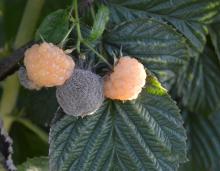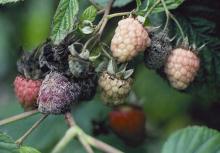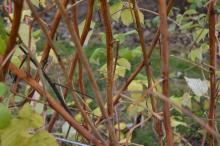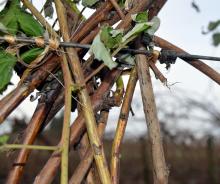See:
Raspberry Cultivar Susceptibility
Cause A survey in 2015 found the majority of isolates to be Botrytis cinerea, a fungus that causes blossom blight, preharvest rot, postharvest rot, and cane infections. Crop losses can exceed 50% in years when rains persist through bloom and into harvest. Crop loss was predicted in Eastern Canada by average humidity and airborne inoculum 1 to 2 weeks prior to bloom.
On raspberry, it overwinters as sclerotia on canes and mycelia in dead leaves and mummified fruit. Sclerotia produce conidia in spring. A moist, humid environment is ideal for pathogen sporulation and spread. Spores are dispersed mainly by wind, but can also be moved by splashing rain or irrigation water. Spores require free water on plant surfaces to germinate and infect. Wet weather (such as rain, heavy dew, fog, or even irrigation) just before and during bloom is important for disease development. All flower parts except sepals are very susceptible. For many years it has been thought that initial infections of flowers are latent such that the fungus is dormant until fruit ripens. Evidence is mounting that flowering may not be a critical time for infection. Fruit maturity may be much more important for disease development. Airborne spore concentrations rise and remain elevated during and after harvest. Fruit rot may be more prevalent in wet weather, in fields under overhead set irrigation systems, or where fruit overripens in the field for mechanical harvest. Conidia can infect mature or senescent leaves, resulting in floricane and sometimes primocane infections through petioles. Cane infections can also initiate through wounds.
Symptoms Rotted fruit, usually with tufts of gray fungus growing on all or part of the berry. In some years, only a few drupelets on a berry may have a fungal growth. Infected berries rarely leak juice. Receptacles of picked fruit also may be colonized and become gray with fungal spores. Rotten fruit may mummify and stay attached to the receptacle. Pale-brown lesions may appear on primocane leaves in mid- to late summer.
A brown, shield-shape lesion may initially be seen around a cane node, which indicates infection via a colonized leaf petiole. This shield shape will be lost as the lesion expands. Cane infections between nodes appear as tan-to brown-lesions and expand in both directions often encompassing more than one node. Cane lesions exhibit typical concentric "watermark" patterns from late summer through late winter. Sclerotia may be visible on canes as shiny, black, blister-like structures. Sclerotia appear on spent floricanes during early fall and later on primocanes in late fall and throughout the winter. Young damaged primocanes may be killed when lesions girdle the cane. Lesions on older primocanes usually do not kill the canes.
Cultural control No single cultural practice provides adequate management of gray mold under highly conducive conditions. Integrate several tactics to manage this disease. The use of cultural tactics reduces reliance on fungicide applications and can help manage fungicide resistance.
- 'Munger', 'Chilliwack', 'Comox', 'Fairview', and 'Meeker' have shown moderate resistance to Botrytis fruit rot. 'Chilcotin', 'Nootka', and 'Willamette' have shown resistance to Botrytis cane infections.
- Create an open plant canopy: use a double top wire training system, prune, avoid excessive nitrogen fertilization, and control weeds. These practices improve air circulation, increase light penetration, and speed drying of plant surfaces after irrigation and rain.
- Avoid excessive nitrogen fertilization.
- Pick fruit in the coolest part of the day. Keep harvested fruit in shade while in the field, and then move to cold storage as soon as possible. Pick frequently so that berries do not become overripe.
- Control early-season primocanes.
- Spotted-wing drosophila (SWD; Drosophila suzukii) management is recommended although a significant correlation has not been demonstrated between SWD and fruit rots. See the PNW Insect Management Handbook for details.
- Adjust irrigation so plants do not stay wet for extended periods of time. Switch from overhead to drip/trickle irrigation.
- Remove fall fruit during tying time.
Chemical control Spray first at 5% bloom and again at 7- to 10-day intervals through bloom. Applications during the growing season, especially preharvest, aid control when wet weather is expected. Thorough coverage and canopy penetration are essential. Fungal strains can become tolerant to a fungicide when it is used exclusively in a spray schedule. To reduce the possibility of tolerance, alternate or tank-mix fungicides that have different modes of action. Minimize the use of any one group of fungicides to no more than twice a year. Strains resistant to 5 different modes of action have been reported from Germany. Resistance to Group 2, 9 and 17 fungicides have been documented in northern Washington. Discontinuation of Group 2 fungicides for many years has resulted in increased sensitivity and allowed its limited reuse once again in this area. Surveys in Oregon from 2014 to 2017 have found Botrytis resistant to fungicide groups 7, 9 and 17. Selection of products for rotation and/or mixing must consider group 7 fungicides when used through the irrigation as a nematicide.
- Bonide Captan 50 WP at 5 Tbsp/gal water can be used in home gardens. Washington only. Do not use within 3 days of harvest. H
- Captan 80 WDG at 2.5 lb/A. Do not apply within 3 days of harvest. Avoid use when honey bees are active due to larval toxicity. Group M4 fungicide. 48-hr reentry.
- CaptEvate 68 WDG at 3.5 lb/A Do not apply within 3 days of harvest or more than 17.5 lb/A/season. Avoid use when honey bees are active due to larval toxicity. Group 17 + M4 fungicide. 48-hr reentry.
- Cueva at 0.5 to 1 gal/100 gal water/A. May be used on day of harvest. Group M1 fungicide. 4-hr reentry. O
- Elevate 50 WDG at 1.5 lb/A. Can be used up to and including the day of harvest. Group 17 fungicide. 12-hr reentry.
- Fontelis at 14 to 24 fl oz/A plus another fungicide. Can be used day of harvest. Group 7 fungicide. 12-hr reentry.
- Iprodione-based products plus another fungicide with a different mode of activity. Can apply the day of harvest. Do not mix with insecticides due to honey bee adult and/or larval toxicity. Group 2 fungicide. 24-hr reentry.
- Iprodione 4L AG at 1.5 to 2 pint/A.
- Meteor at 1.5 to 2 pints/A.
- Rovral 4 Flowable at 1.5 to 2 pint/A.
- Kenja 400 SC at 13.5 to 15.5 fl oz/A. Do not use within 7 days of harvest. Group 7 fungicide. 12-hr reentry.
- Luna Tranquility at 16 to 27 fl oz/A. May be used day of harvest. Group 7 + 9 fungicide. 12-hr reentry.
- Oso SC at 6.5 to 13 fl oz/A. May be applied on the day of harvest. Group 19 fungicide. 4-hr reentry. O
- Ph-D WDG at 6.2 oz/A plus an adjuvant. May be applied on the day of harvest. Group 19 fungicide. 4-hr reentry.
- Pristine at 18.5 to 23 oz/A. Do not use with any other tank additive. Can be used day of harvest. Combination of Group 7 and 11 fungicides. 12-hr reentry.
- Switch 62.5 WG at 11 to 14 oz/A. May be used up to and including the day of harvest. Combination of Group 9 and 12 fungicides. 12-hr reentry.
Note: Tests in western Washington have shown that Serenade and Regalia do not control this disease and are not recommended.
Protexio is registered but is not being sold due to the garlic-like odor it leaves on fruit.
Biological control Many different organisms have been shown to be effective under controlled conditions but control becomes more variable in the field. Combine with cultural tactics and/or integrate with synthetic fungicides for best effectiveness.
- Botector (Aureobasidium pullans strains DSM 14940 and 14941) at 5 to 10 oz/A depending on water volume. Can be applied day of harvest. Compatible with sulfurs, oils and a few fungicides but not with many synthetic fungicides. 4-hr reentry. O
- BotryStop (Urocladium oudemansii U3 strain) at 2 to 4 lb/A. Keep refrigerated before use. Compatible with many wetting agents, some fungicides and biologicals but not all. Unknown efficacy in the PNW. 4-hr reentry. O
- DoubleNickel 55 (Bacillus amyloliquefaciens strain D747) at 0.25 to 3 lb/A. Unknown efficacy. Group BM02 fungicide. 4-hr reentry. O
- Howler Evo (Pseudomonas chlororaphis strain AFS009) at 20 to 120 oz/A plus a surfactant. Can be used day of harvest. Unknown efficacy. 4-hr reentry. O
- LALStop G46 WG (Clonostachys rosea [formerly Gliocladium catenulatum] strain J1446) at 0.3 to 16 oz/A. Do not use with other products in the tank. 4-hr reentry. O
- Stargus (Bacillus amyloliquefaciens strain F727) at 2 to 4 quarts/A. Can be used up to and including harvest. Group BM02 fungicide. 4-hr reentry. O
References Carisse, O., McNealis, V., and Kriss, A. 2018. Association between weather variables, airborne inoculum concentration, and raspberry fruit rot caused by Botrytis cinerea. Phytopathology 108:70-82.
Jones, L.A., and Pscheidt, J.W. 2015. Findings on the life cycle and biology of Botrytis cinerea causing cane botrytis on red raspberries in the Pacific Northwest. Phytopathology S4:66 (abst)
Kozhar, O., Larsen, M. M., Grünwald, N. J., and Peever, T. L. 2020. Fungal evolution in anthropogenic environments: Botrytis cinerea populations infecting small fruit hosts in the Pacific Northwest rapidly adapt to human-induced selection pressures. Applied and Environmental Microbiology, 86(9) e02908-19.







